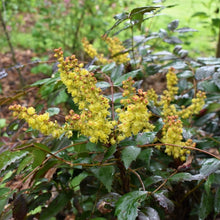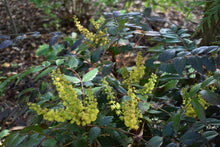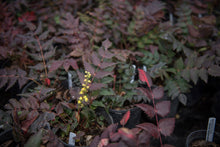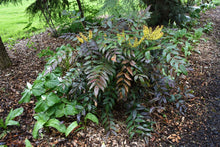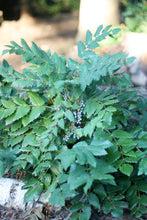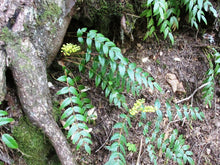
Mahonia nervosa / Berberis nervosa
Like its cousins, cascade Oregon grape has a place in any Pacific Northwest woodland garden. Growing about two feet tall, its pale-yellow flower clusters erupt from the center of the plant each spring, above whorling stems of spiky compound leaves. Deep blue berries ripen in late summer to fall providing food for birds and other wildlife.
- Plant type/canopy layer: evergreen, perennial, small shrub
- Size at maturity: 2' tall, 2' wide
- Light requirements: part sun to full shade
- Moisture requirements: dry to moist soil
- Bloom time: March - June
- Growth rate/ease: slow growing, easy to grow
- Wildlife support: flowers attract and provide nectar to adult butterflies, bees and other insect pollinators, attracts and supports beneficial and other pest eating insects, attracts and supports hummingbirds, berries are eaten by backyard birds and small mammals
- Native habitat/range: common in open or shaded woods, rocky areas up to 2200m mainly west of the Cascades, north to British Columbia. Portland Plant List - yes.
- Special features & uses: evergreen, overall wildlife favorite, including hummingbirds - but deer resistant; medicinal; landscape uses include erosion control, habitat hedgerows
Gardening with Cascade Oregon Grape: Its small stature and growing ease make Cascade Oregon Grape an ideal choice for woodland gardens. It prefers shade to part shade and moist, well-drained soils - but can tolerate summer drought and the dry shade under mature trees in cooler areas, once established. Consider it in the understory of vine maple and osoberry, interplanted with ferns, salal and oxalis. Also considered deer resistant.
Photo Credits 1, 2, 4: Nikkie West, Sparrowhawk Native Plants
Photo Credit 3: Hoddick Photography
Photo Credit 5: Karli Del Biondo, Beetles and Bees
Photo Credit 6: "Mahonia nervosa (Dwarf Oregon-Grape)" by brewbooks is licensed under CC BY-SA 2.0.






